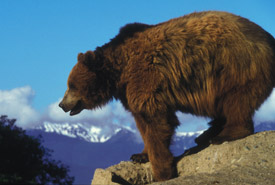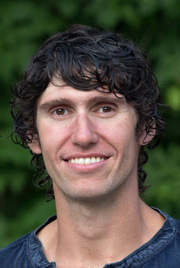Excerpt: Safe Passage

Grizzly bear (Photo by Erwin and Peggy Bauer/USFWS)
On a soggy September afternoon in southeast British Columbia, Nancy Newhouse swung her truck through a bank of pearl-colored fog and bounced to a halt on the shoulder of Highway 3A. Newhouse, Tom Swann and I emerged into the cold mist, stepping carefully around the puddled ruts carved in the pullout. A convoy of logging trucks, their beds heavy with timber, sprayed mud at our shins. Adjusting our raingear, we began trudging north along the highway; to our left, a screen of cedar, spruce and Doug fir shielded the valley below. After a hundred yards, the curtain thinned, and Newhouse stopped.
“There it is,” she said, the hood of her Nature Conservancy of Canada (NCC) raincoat pulled low over her eyes. She pointed through the trees, toward the floor of the Creston Valley. “There’s the corridor.” I followed her finger, baffled. Sorry, I wanted to ask, but where’s the corridor? I searched in vain for signage. A non-descript swath of grainfields glimmered through the shifting fog. The land lay flat, furrowed with oats. The brown arm of a dike, built to stave off the floodwaters of nearby Duck Lake, wormed across the property.
Though the land appeared mundane to my human eye — Yellowstone it wasn’t — from a grizzly bear’s standpoint you’d be hard-pressed to find a more important parcel in North America. This humble polygon of farmland, dubbed the Frog Bear Conservation Corridor, was a crucial piece in a two- thousand-mile puzzle, a bridge that would allow isolated clusters of Ursus arctos horribilis to mingle and mate.
“This movement corridor is well known,” Swann, Newhouse’s colleague at Nature Conservancy of Canada, told me as raindrops pooled in his trim white beard. “The science is clear.” That science was why NCC had recently purchased and protected 679 acres (275 hectares) of the Creston Valley. Though the land’s $2.5 million price tag was steep, Newhouse and Swann had help: over half the funds had come from the Yellowstone to Yukon Conservation Initiative, one of the world’s most ambitious wildlife groups.
The organization’s advocates dream that the effort will preserve migration routes for caribou and wolves, link pockets of far-ranging creatures like wolverines and help animals of all sizes flee northward in the face of climate change. The group’s totem, however, is the grizzly, whose expansive habitat requirements make it a useful umbrella for protecting other species. If an ecosystem can support bears, it’s probably healthy enough for everything else.
The acquisition of those 679 acres represents the apotheosis of Y2Y’s approach to conservation, in which habitat connectivity reigns supreme. For a century, environmentalists focused on protecting scenic places — the peaks and ridges that define, say, Glacier National Park — at the expense of valley bottoms, the fertile areas we’ve commandeered for crops and towns. Just as Frog Bear isn’t classically beautiful, neither is it remote: the town of Creston lies just a few miles south. As it turns out, grizzlies and humans share similar taste in habitat. For wildlife, the valleys that we’ve colonized are natural travel corridors, each feeding into the next, sewing landscapes together.
Excerpted from “Safe Passage,” by Ben Goldfarb. Published by Orion and used with permission of the publisher.


